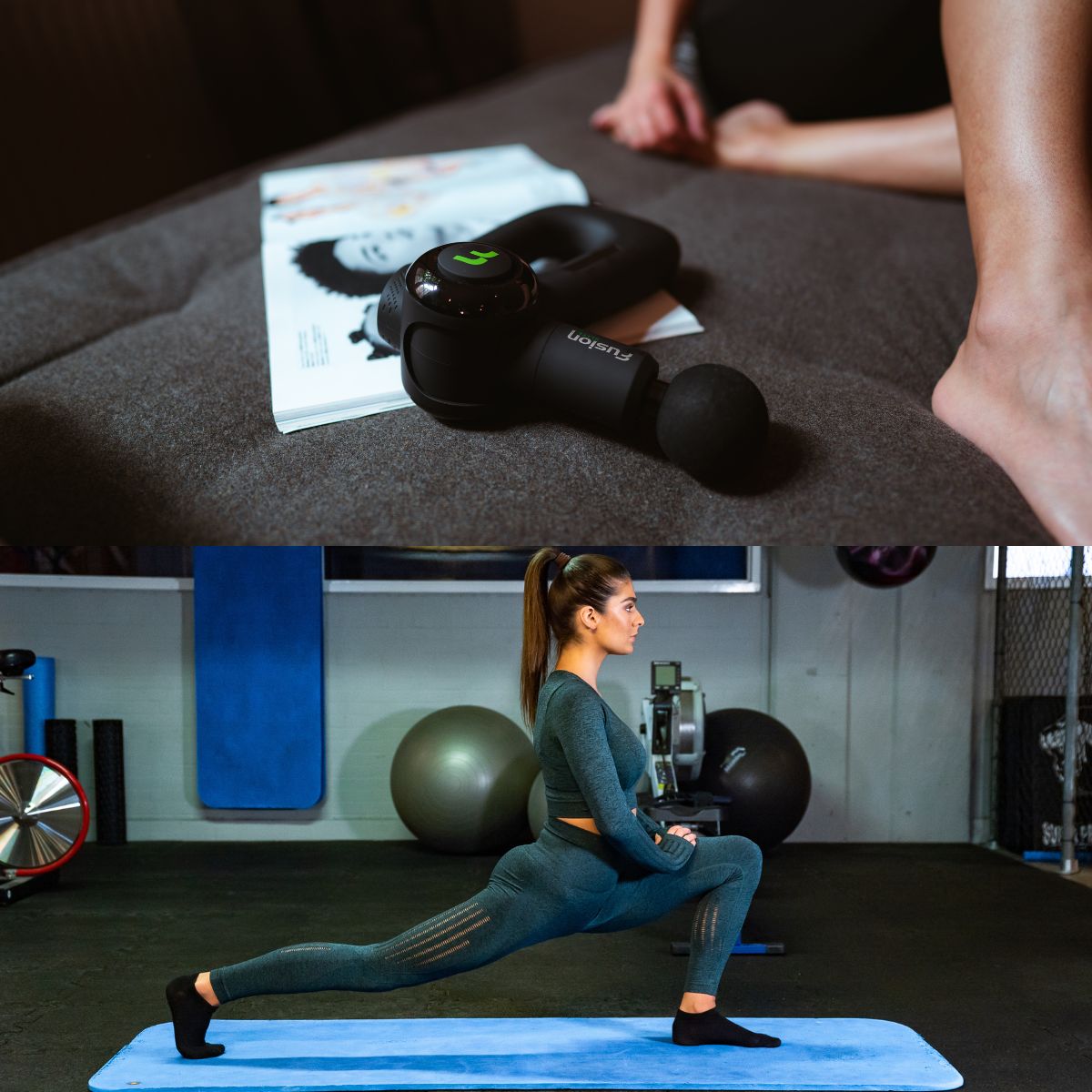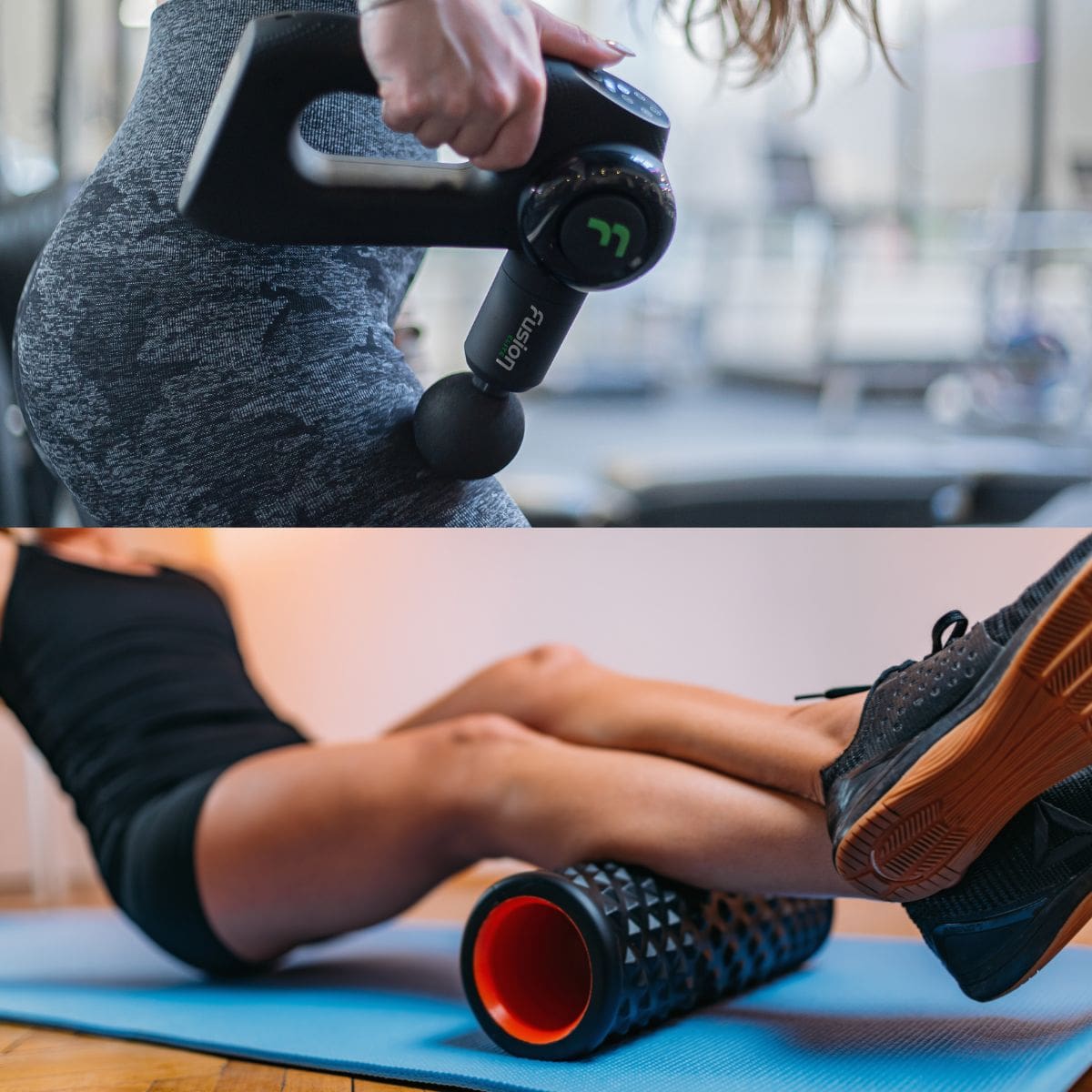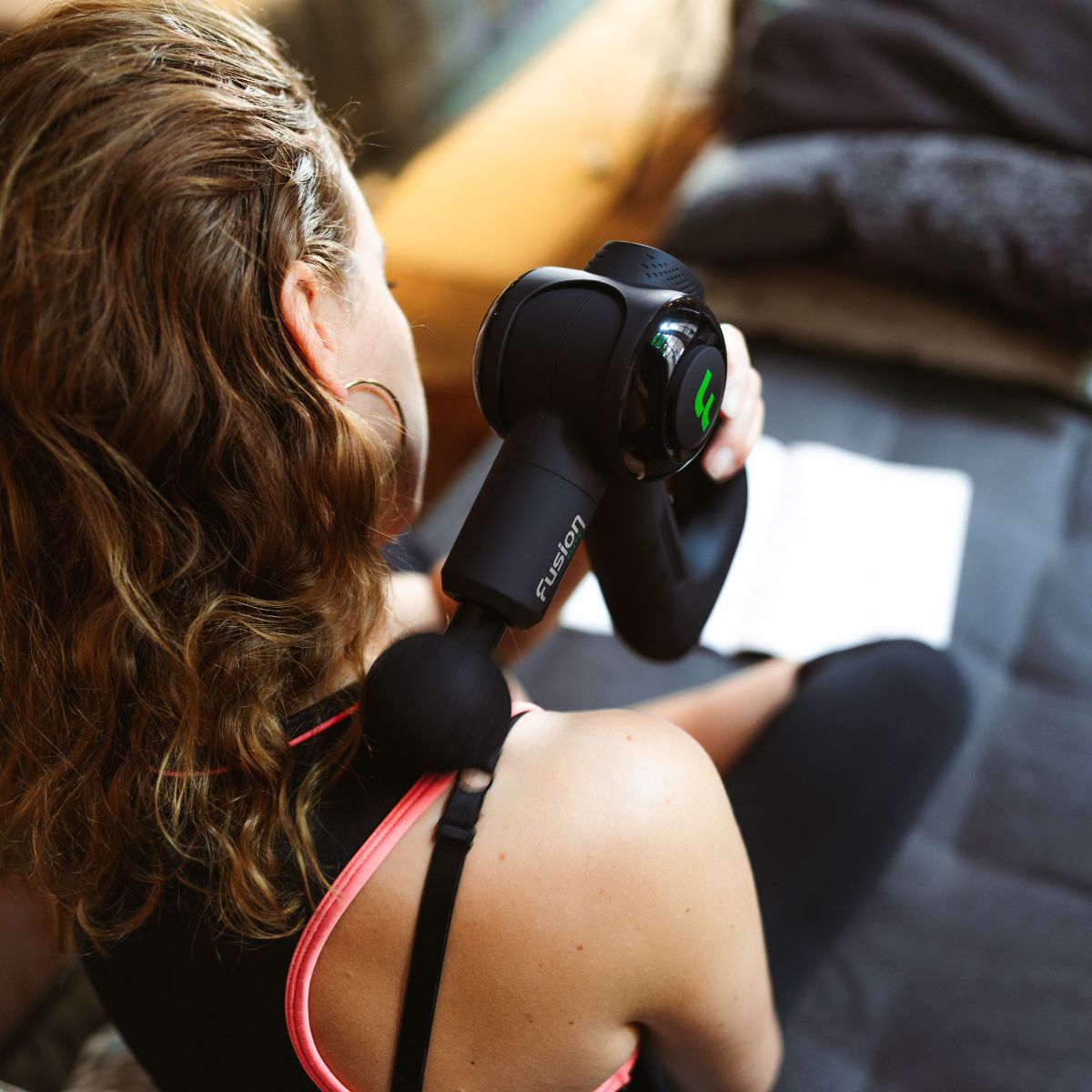When it comes to relieving muscle aches, many people are stuck between using massage guns or performing stretching exercises.
These recovery methods are beneficial for muscle recovery and can reduce soreness and improve flexibility.
But which one is better? Which one accelerates muscle relief from soreness and tightness? Can they be used together?
Well, providing answers to these questions is not straightforward as it depends on the individual and their needs.
Many people find percussive massage treatment to be more effective than performing stretching exercises for muscle recovery, while others the latter to be more beneficial.
In this post, we will discuss the pros and cons of both massage guns and stretching to help you decide which one is better for your muscle recovery. You'll also learn whether or not they can be used together.
But first, let's start with a brief overview of how these recovery methods play a role in muscle recovery.
Let's get started!
Comparing Massage Guns vs. Stretching
Choosing between these two recovery methods can be tricky as both have their own advantages and disadvantages. In this section, you'll better understand what how using massage guns and performing stretches are and how they can help with muscle recovery.
1. Understanding massage guns
When you think of massage guns, what do you imagine?
Do you think of a handheld tool that gives you a deep tissue massage? Or maybe you think of a percussive device that vibrates and helps to reduce muscle tension?
You're not so far off!
Massage guns are handheld devices that have become increasingly popular for muscle recovery. They use percussive therapy, which is a type of massage that uses rapid pulses to stimulate your sore muscles.
This type of massage helps to reduce muscle tension and soreness, improve circulation, and increase range of motion. In the next section, we'll discuss the pros and cons of incorporating massage guns into your fitness routine.

2. Pros of using a massage gun
Using a massage gun provides a number of benefits for muscle recovery. Some of them include:
Provides pain relief from muscle soreness or tightness
Are you dealing with muscle soreness or tightness?
If so, a massage gun can help to reduce pain and discomfort.
Muscle tension and soreness occur when the muscles are overworked and don't have enough time to recover. Lactic acid builds up in the muscles, causing them to become tight and sore.
Using a massage gun can help to reduce this lactic acid buildup, which in turn can reduce muscle pain and discomfort. With low lactic acid levels, your muscles can recover faster and you can get back to your workouts sooner.
Increases muscle blood flow
One of the main benefits of using a massage gun is that it helps to increase circulation within your muscles.
When you place a massage gun on a muscle, rapid bursts of pressure help to increase blood flow to the area. Improved circulation also helps to deliver oxygen and nutrients to the muscles, which is essential for muscle recovery.
What's more, increased blood flow helps to reduce inflammation, which can help to reduce soreness and improve flexibility.
Encourages the elimination of scar tissues
Using a massage gun can help to encourage the elimination of scar tissues.
Scar tissue is formed when the body repairs itself after an injury, and it can cause tightness and stiffness in the muscles.
Massage guns are designed to break down these scar tissues, which helps to reduce muscle tension and improve range of motion. This can be especially beneficial if you're dealing with an old injury.
Increased mobility
Are you having a hard time getting into certain poses or stretches during your workouts?
Using a massage gun can help to improve your mobility. The rapid pulses help to loosen tight muscles, which can help you move more freely and get into those hard-to-reach poses.
This can be especially beneficial for professional athletes who need to stay flexible and mobile for their sport. With improved mobility, you'll be able to perform better and prevent any risk of injury.
So, these are just a few awesome benefits of choosing a massage gun over stretching exercises. Now, let's look into the drawbacks of using these devices.
3. Cons of using a massage gun
While there are many benefits to using a massage gun, there are also some drawbacks that you should consider before incorporating them into your fitness routine.
Can be too intense
One of the main drawbacks of getting massage therapy with a massage gun is that it can be too intense for some people.
The vibration and percussion can be uncomfortable or even painful for those with sensitive skin or muscles. If the massage gun is too intense, try using a lower adjustable setting or a softer attachment.
Relies on a battery
Another drawback of using a massage gun is that it relies on a rechargeable battery.
This means that you need to make sure the device is fully charged before each use, or else you won't be able to enjoy its benefits. What's more, if the battery runs out during your session, you'll have to stop and wait for it to recharge before continuing.
Can be expensive
Enjoying the maximum benefits of a massage gun can be expensive.
These devices range in price from $100 to over $500, depending on the features and interchangeable attachments you choose. However, popular brands like Fusion Recovery offer high-quality and affordable massage guns worth the investment.
But if you're on a budget, you may want to consider other options, such as foam rolling or stretching. Let's look into what stretching can do for your muscle recovery in the next section. We'll also look at its pros and cons.
4. Stretching

Taking part in stretching exercises is a great way to get your muscles ready for a workout and to reduce muscle tension and soreness afterward.
It helps to increase your range of motion, improve flexibility levels, and reduce the risk of injury.
With stretching, there's no need to invest in any expensive equipment. You can do it anywhere and anytime, making it an excellent option for those on a budget.
Examples of stretching exercises include dynamic stretching, static stretching, and foam rolling.
Let's look at the pros and cons of stretching.
5. Pros of stretching
Using stretching exercises for muscle recovery promises many benefits. Some of them include the following:
Expands flexibility
One of the main benefits of performing stretching exercises is that it helps to enhance your muscle flexibility level.
When you stretch, your muscle elasticity increases, allowing you to move more freely and reach those hard-to-reach poses. This can especially be beneficial for athletes who need to stay flexible and mobile for their sport.
Improves physical performance during activities
Are you about to engage in an intense physical activity and don't want to risk an injury?
Stretching can help you get the most out of your performance. By stretching your muscles, you can increase your range of motion, which can help you move more efficiently and with greater power.
This can especially be beneficial for athletes who need to stay flexible and mobile for their sport.
Improves your body posture
Another benefit of performing stretching exercises is that it can help to improve your body posture.
Sitting or standing in the same position for long periods of time can cause muscle stiffness and tightness. Stretching can help to loosen these tight muscles, allowing you to stand or sit in a more upright position.
When you have better posture, you can also reduce the risk of back pain and other aches and pains.
Relieves stress
Stretching is also a great way to relieve stress.
People who are constantly under stress tend to experience tightness in their muscles, which can lead to tension headaches and other aches and pains.
Stretching can help to relax these muscles, allowing you to release the built-up tension and stress. With improved mood and relaxation, you can also improve your overall quality of life.
Increases blood circulation
Just as massage guns, stretching can help to increase blood circulation.
This helps to deliver more oxygen and nutrients to the muscles, which can help with muscle recovery. It can also help to reduce inflammation and improve overall health. Next, we'll look at the cons of performing stretching exercises for muscle recovery.
6. Cons of stretching

While stretching has many benefits for muscle recovery, there are also some drawbacks. Some of them include the following:
Can't target hard to reach areas
One of the drawbacks of participating in stretching exercises is that it can be difficult to target hard-to-reach areas. For example, if you have a tight spot in your lower back, it can be difficult to stretch this area without assistance.
In contrast, massage guns are designed to target hard-to-reach areas with ease. The gun’s head is designed to reach deep into the muscle tissue, allowing you to target specific areas with precision.
Can be time consuming
Another drawback of incorporating stretches in your fitness routine is that it can be time consuming.
Depending on the type of stretch you are performing, it can take several minutes to complete a single stretch. In contrast, massage guns are much faster and more efficient.
With just a few minutes of use, you can get the same benefits as stretching without having to spend as much time. This can especially be beneficial for athletes and fitness enthusiasts who need to recover quickly.
Risk of muscle tear
Performing stretching exercises can also come with the risk of muscle tears.
When stretching, it is important to be mindful of your body and not push yourself too far. If you overstretch, you can cause damage to the muscle fibers, leading to muscle stiffness and discomfort. This can be especially dangerous if you are engaging in intense physical activities and need quick muscle recovery.
So there you have it, the pros and cons of stretching for muscle recovery.
While stretching can be beneficial, it's important to remember that it can also be time-consuming and carries a risk of injury if done incorrectly. Ultimately, the choice between using a massage gun or stretching for muscle recovery is up to you.
To help make an informed decision, let's compare how these workout recovery tools can help with muscle recovery.
Main Differences Between Using a Massage Gun Vs. Stretching
With similar benefits of increased flexibility, improved blood circulation and improved physical performance, picking between a massage gun and stretching can be difficult. Let's see how they compare to help you make an informed decision.
1. Time
One of the main differences between using a massage gun and stretching is the time it takes to complete.
And when it comes to this, massage guns are the clear winner. A massage gun can be used in just a few minutes. All you have to do is press the gun against your skin and let it do its job.
Stretching, on the other hand, requires more time and effort as you have to hold each stretch for several minutes. This makes a massage gun ideal for those who have limited time and need quick muscle recovery.
2. Intensity
Are you looking for a more intense workout recovery? If so, then a massage gun is the way to go.
Massage guns are designed to target deep muscle tissue and provide a more intense massage than stretching. This can help improve blood circulation and reduce muscle soreness faster.
Stretching, on the other hand, is not as intense as using a massage gun. It can still be beneficial for muscle recovery, but it may take longer to see results.
3. Cost
Another factor to consider when choosing between massage guns and performing stretching exercises is cost.
Massage guns can be expensive, depending on the type you purchase. However, they can last for years if properly maintained. Stretching, however, is a cost-effective way to improve your workout performance.
It does not require any special equipment giving it a cost advantage over massage guns.
4. Safety
Finally, safety is another factor to consider when choosing between a massage gun and stretching.
Massage guns are generally considered safe as long as you use them correctly, while stretching can come with the risk of muscle tears if done incorrectly. That's why it's important to be mindful of your body and not push yourself too far.
So, there you have it, an in-depth comparison of massage guns and stretching for muscle recovery.
Which one makes the most sense for you?
Both methods can be beneficial for muscle recovery, but the best option for you will depend on your individual needs and preferences.
Frequently Asked Questions
After exploring this topic, you may still have a few questions. Here, we have tried to provide answers to many of those questions – from the most basic to the most complex. Let's look at some frequently asked questions about massage guns and stretching.
How often should I use a massage gun compared to performing stretching exercises?
The frequency of using a massage gun or performing stretching exercises will depend on your individual needs and preferences.
Are you looking to speed up recovery after an intense workout? Or maybe you want to enhance your athletic performance before a tough workout session for better results?
Whatever your goal may be, it's important to stick to a usage schedule that works best for you. Generally, it's recommended to use a massage gun 2-3 times daily while stretching exercises can be performed 2-3 times a week.
Can I combine using massage guns with performing stretching exercises?
Yes, you can!
Combining massage guns with stretching exercises can be a great way to maximize your muscle recovery and performance. Massage guns can help provide deep muscle tissue therapy for faster recovery while stretching can help improve your body muscle elasticity and flexibility.
With that said, it's important to be mindful of your body and not overdo it. Make sure to take breaks in between sessions and listen to your body for any signs of discomfort.
Are there any risks associated with using a massage gun versus stretching?
Yes, there are risks associated with using a massage gun versus stretching.
When using a massage gun, it is crucial to be aware of the potential for overuse injuries. Additionally, if the massage gun is used too frequently on open wounds or bruises, it can cause skin irritation or bruising.
Stretching, on the other hand, can come with the risk of muscle tears if done incorrectly as we've mentioned earlier. That's why it's important to be mindful of your body and not push yourself too far.
Conclusion
Now that you have a better understanding of massage guns and stretching for muscle recovery, you can make an informed decision about which one is best for you.
Both methods can be beneficial for muscle recovery, but the best option for you will depend on your individual needs and preferences. Many elite athletes and fitness enthusiasts often prefer using massage guns for muscle recovery as it helps to reduce muscle soreness and fatigue in an effective manner.
They come with a wide range of soft attachment heads that make it easier to target hard to reach muscle groups. That doesn't mean stretching exercises should be neglected.
Stretching can help improve your body's flexibility and range of motion, which is essential for any athlete or fitness enthusiast.
As we mentioned in the FAQs section, you can even combine percussion massagers with stretching exercises for maximum muscle recovery and performance.
Whatever you decide, make sure to be mindful of your body and not overdo it. Always take breaks in between sessions and listen to your body for any signs of discomfort. Let us know in the comments below which method you prefer for muscle recovery!





